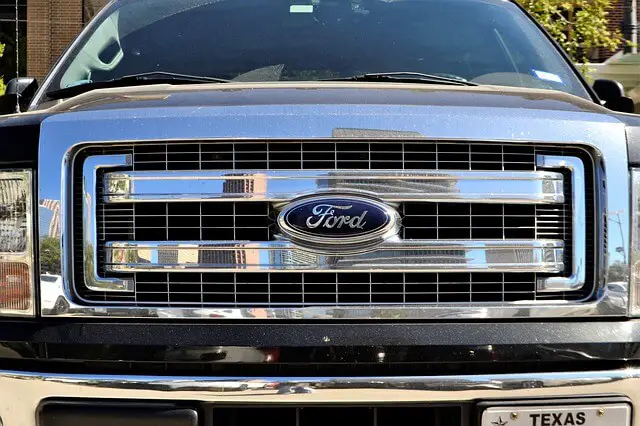There are many vibrations, noise, and clunk issues people notice that come at both the front and rear end of the FordF150 truck.
If you carefully define the problem, it will be half solved. Vibration is the phenomenon that you feel while driving.
Noise is the one which you do not feel but hear. Here comes the clunking issue, the issue is the same as the noise but it comes in pairs like thunk, thunk.
Many folks experience Ford F150 clunk issues while driving on an inclined road or an up gradient similar to when pulling in or out of the driveway, like when one wheel goes over the bump and then the other wheel on some uneven rough road surfaces.
Some experience it while starting from a standstill, whereas others report the issue in normal driving, especially when accelerating.
The Ford F150 rear end clunk issue happens typically due to improper greasing of dry driveshaft slip yoke splines, loose leaf spring U bolts, bad leaf spring isolator pads, improper lubrication of the leaf spring, bad driveshaft U-joint, or a faulty LSD.
Here in this article, we are going to find out the reasons and solutions for the Ford150 rear end clunk issue in detail. So, stay tuned!
Table Of Contents
Ford F150 Rear End Clunk? 7 Reasons And Solutions To Fix It!
The FordF150 rear end clunk happens while driving when there is metal-to-metal contact between different parts.
It is recommended that you would stand behind the vehicle’s rear end and observe where the clunk sound comes from while someone slightly pushes the truck and look visually for any problem.
Ensure that you are maintaining enough distance from the moving parts, otherwise, you may get hurt.
Before you start troubleshooting the clunking issue, you shall ensure that there are no loose mounting points of different parts like spare tires, shields, etc, and the rear bed is fully screwed to the vehicle chassis.
If the issue is related to rear end vibration, then it needs different troubleshooting altogether.
Below are the probable issues for the FordF150 rear end clunk issue.
Lubricate driveshaft slip yoke splines
A driveshaft is a part that transfers power from the transfer case to the rear differential.
The drive shaft does it with the help of universal joints and slips yoke joints to take care of up and down movements of the rear axle as per suspension motion.
The U-joints typically take care of angular movements of the drive shaft but since the distance between the transfer case and rear differential is fixed, it requires back and forth movement of the drive shaft to accommodate the constant up and down movements of the suspension, that is where the driveshaft slip yoke joint comes into play.
The driveshaft has external splines that would slide onto the slip yoke having internal splines to adjust the driveshaft length and it is designed such that the driveshaft will not completely come out of the slip yoke during up, down, back, and forth movements of the driveshaft.
The slip yoke also has a seal that keeps the spline joint clean and it is connected to the flange yoke bolted to the rear axle.
Typically, the lubricating grease is applied to the slip yoke joint splines to ensure smooth friction-free movement of the sliding joint.
It is noticed that once the vehicle covers certain mileage, the applied grease either gets dried up or the quality deteriorates and creates a clunk sound at the rear end in your FordF150 especially while driving at low speeds. This is an issue in many trucks and SUVs.
The transfer case will be subjected to heavy drive line stresses and hence the drive shaft in addition to up and down movement shall absorb the flexing motions of the transmission mounts.
But when the slip yoke joint goes dry, it would not be able to absorb all loads, and forces, and finally results in the FordF150 rear end clunk noise.
Fix
The FordF150 rear end clunk issue can be fixed by applying Teflon grease (PTFE grease) to the slip yoke joint, but make sure that you remove the factory grease from the slip yoke joint before applying Teflon grease.
The FordF150 rear end clunk issue is more prevalent in trucks with a two-piece drive shaft than the single-piece drive shaft since it has to absorb more misalignments in that case. Teflon grease can be the one-stop solution.
But often, the grease lasts for a couple of months and the clunking noise returns.
Hence it is necessary to apply good quality Fordslip grease kit that comes with a boot instead of applying local grease to it.
If your vehicle has a zerk fitting at the slip joints, it would indeed make your life easy while applying the grease to the slip yoke joint.
Loose U-bolts
The FordF150 rear end clunk issue is noticed when there is the movement of the U-bolts and nuts holding the rear leaf springs.
It is possible that the U-bolts and nuts can get loosened due to vibrations over a period of running unless it is tightened to specified torque you may experience rear end cluck in FordF150.
It is worthwhile to note that once the U bolts and nuts are removed from the leaf springs, it is necessary to replace them with a fresh ones. Do not use the old one, it is because of how it is threaded to each other.
Also while applying the torque to the U-bolts and nuts, it is not to be applied in one go. It is to be applied in 4 stages like 30 lb.ft (40 N.m), 59 lb.ft (80 N.m), 89 lb.ft (120 N.m), and 111 lb.ft (150 N.m) to ensure the trouble-free performance.
You would also inspect, loosen and retorque rear spring shackle bolts based on its conditions.
Bad leaf spring isolator pads
If your vehicle has a single drive shaft without a slip yoke joint, then the issue may lie in the leaf spring.
Whenever there is a squeaking or grinding or clunking issue in the rear end of a FordF150, then it could be bad leaf spring isolator pads which is a typical issue on older generation trucks.
The spring isolator pads or bushings are placed in between the master leaf spring and the leave immediately beneath it to avoid direct metal-to-metal contact between them.
But when this piece of plastic or bushings wears down after a while, it creates a huge clunking noise from the rear end.
Often a dealer would recommend replacing the leaf spring and the shackles but that would not solve the problem, it will come back again once the isolator pads are worn out.
There are many aftermarket bushings available in auto shops, you may try those isolator pads and confirm that the FordF150 rear end clunk issue vanishes, Otherwise, you would need to replace the isolator pads now and then (say 50000 km)
Lubricate leaf spring
The improper lubrication or greasing of the leaf springs can be one of the possible root causes of the rear end clunk issue in your FordF150.
There are several metal-to-metal contacts when the leaf spring assembly is connected to the drive axles.
A movement between the rear spring and rear spring mounting plate on the rear axle or a motion between the axle and leaf spring seat would make a FordF150 rear end to make pop, snap, or a clunking noise especially when driving up and down on an inclined surface similar to entering or leaving driveway.
Steps to lubricate the leaf springs are as below
- Pull the lower shock bolt out of the housing, let the shock hang, and support the axle tube
- Remove the U bolts and nuts and take the axle off from the spring seat,
- Clean the surface under the leaf spring and clean the surface at the actual mounting spot top and bottom and apply either ford special grease or WD40 grease spray between the rear spring and rear spring mounting plate mating surface.
- Similarly apply Fordgrease and separate the rear axle from the spring seat to prevent direct metal contact.
- Do not forget to lubricate the bushings of the leaf springs at the shackle joints.
- Remove and discard the rear shock bolt from the absorber. Replace the nut and bolts.
- Clean the mating surfaces for the spring spacer for any debris.
- Once everything is done, bolt all the things back.
Spray Liquid wrench
If you are running out of time and following the above steps to lubricate the leaf springs seems too hectic for you, then as a temporary solution, you can simply crawl under the vehicle’s rear end and spray the liquid wrench on the spring leaves where there are bolting arrangements.
It would provide a fluid film on the leaf spring and prevent metal-to-metal contact which creates a rear end clunk in FordF150 while driving.
Bad driveshaft U-joint
In a vehicle that has rear end clunk, often the universal joints are found to be defective or loose.
A loose or a bad U-joint would not be able to handle and transfer the high torque efficiently from the transfer case to the rear differential and may lead to rear end clunk at take off, especially while driving upgradient.
Also, a little play in the U-joints would lead to vibration and clunk when driving.
Hence it is essential to inspect and replace the U-joints, but ensure that you assemble well-balanced drive shaft assemblies by marking it before dismantling. Any change in orientation may lead to an imbalance in drive shaft assemblies.
Faulty LSD
The Limited slip differential helps in ensuring the vehicle rolls out of situations wherein one wheel is on a low traction surface and the other is on a good one.
But often engaged LDS would do clunking noise in FordF150 in case of damaged clutch packs.
You may lock and unlock the LSD by switching it ON/OFF, if the clunking issue vanishes then it is the LSD that you shall target.
The worn out clutch packs are the major root cause for the system of rear end vibration especially when turning.
Fix
Use more friction modifiers in your differential oil. Typically, you need to add 5 to 6 ounces of friction modifier to gear oil. for LSD.
Since the friction modifier ensures that there is limited slip at the interface of the clutch packs with the friction discs while negotiating a turn, it would reduce the chattering or clunking noise that comes from the rear end differential.
If it doesn’t solves the problem, then you may need to replace the clutch pack by following the suitable procedure.
Needless to mention that you shall confirm that there is enough good grade of differential fluid inside the case.
Final Thoughts
The Ford F150 rear end clunk issue is typically related to a dry or insufficient grease in the driveshaft slip yoke joint or something to do with the improper lubrication and torquing of the leaf spring bolts and nuts.
We have tried to collate all possible root causes and solutions to address the clunking issue at rear end of Ford F150.
Hope this article helps you in identifying the root cause and pin-point to zero-in on the problem area.
Happy Motoring!
References
https://www.f150forum.com/f118/rear-end-clunk-348251/
https://www.f150gen14.com/forum/threads/clunking-noise-in-rear-end.4988/
https://www.f150online.com/forums/2004-2008-f-150/417858-rear-end-clunk-when-taking-off.html
Related Articles
F150 Hub Actuator Noise: 4 Troubleshooting Tips to Silent the Clatter
Looking For Ford F150 4×4 Actuator Bypass? Everything You Need To Know!
Ford F150 Front End Noise When Turning? 12 Causes And Solutions To Fix It!
F150 Grinding Noise When Accelerating? 8 Reasons And Solutions To Fix It!
Why the Car Shakes In Reverse? 7 Causes And Solutions To Fix It!
Ford F150 knocking noise when starting? 11 Causes And Solutions To Fix It!
Ford F150 Sputtering When Accelerating? 12 Causes and Solutions To Fix it!

